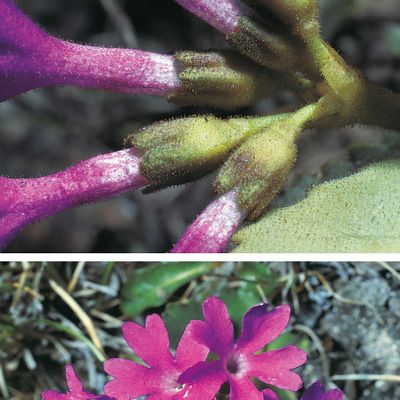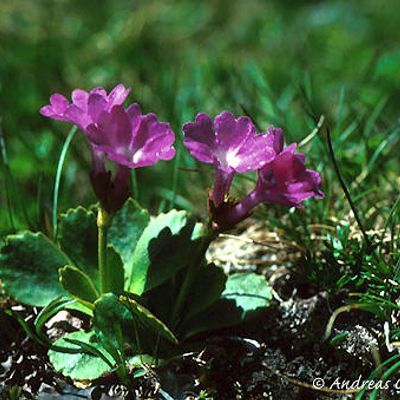Primula daonensis (Leyb.) Leyb.
1036190
Species
ISFS : 325900
Checklist : 1036190
ISFS : 325900
Checklist : 1036190
Contains :
Synthesis
Species description (© Flora Helvetica 2018)
3-10 cm hoch, Stängel die Blätter überragend. Diese rundlich-oval, meist grob gezähnt, mit geflügeltem Stiel, drüsig behaart, Köpfe der Drüsenhaare hell- bis dunkelrot. Blüten in 2-5blütigen Dolden, rosa bis purpurn, mit ausgerandeten Zipfeln und weissem Schlund. Blütenstiele 2-6 mm lang. Kelchzähne anliegend, 0,8-1,5 mm lang, breit gerundet, meist breiter als lang. Frucht so lang wie der Kelch oder länger. Vgl. P. hirsuta, Nr. 1354.Flowering period (© Flora Helvetica 2018)
6-7Habitat and distribution inside Switzerland (© Flora Helvetica 2018)
Rasen, Felsschutt / alpin / GR (Münstertal)World distribution (© Flora Helvetica 2018)
BergamaskischEcological indicator (© Landolt & al. 2010)
322-41+3.h.2n=62,63,64Status
IUCN status
Near threatenedNational Priority
3 - medium national priorityInternational responsibility
3 - highConservation
Threats
Strassenbau, Unterhaltsarbeiten
Beweidung, Tritt
Attraktivität (Sammeln, Ausgraben)
Kleine isolierte Populationen, Datendefizit
Distribution map
Habitat and distribution inside Switzerland
GR (Münstertal)World distribution
BergamaskischEcology
Life form
Perennial hemicryptophyte
Habitats
Milieux Phytosuisse (© Prunier et al. 2017)
Habitats © Delarze & al. 2015
 | 4.3.7 - Krummseggenrasen (Caricion curvulae) |
bold
Dominant species, influencing the appearance of the habitat
 Character species
Character species
 Less strictly linked to a specific habitat
Less strictly linked to a specific habitat
Ecological indicator values by © Landolt & al. (2010)
| Soil factors | Climatic factors | Salinity tolerance | |||
|---|---|---|---|---|---|
| Humidity Value H | 3 | Light Value L | 4 | Salinity Index | -- |
| Reaction Value R | 2 | Temperature factor T | 1+ | ||
| Nutriments value N | 2 | Continentality K | 3 | ||
- Ecological values legend
Humidity Value H 1 very dry 1+ dry 2 moderatly dry 2+ moist 3 medium wet 3+ wet 4 very wet 4+ soggy 5 submerged or underwater f plants living in running water u mostly submerged plants v partly submerged, partly floating plants w humidity moderately variable (± scale of 1-2) w+ highly variable humidity (scale exceeding ± 2) Reaction Value R 1 Very acid (pH 2.5-5.5) 2 acid (pH 3.5-6.5) 3 lightly acid to neutral (pH 4.5-7.5) 4 neutral to basic (pH 5.5-8.5) 5 basic (pH 6-5 -> 8.5 Nutriments value N 1 very low in nutrients 2 low in nutriments 3 medium-poor to medium-rich in nutrients 4 rich in nutriments 5 very rich in nutriments Salinity tolerance 1 halotolerant 3 halophyle Light Value L 1 very shady 2 shady 3 lighted areas 4 luminous 5 highly luminous Temperature factor T 1 alpine to nival stages (from the treeline to the snowline) 1+ suprasubalpine and upper subalpine levels (pine and larch forests) 2 subalpine level (coniferous forests without beeches up to the upper limit of spruces) 2+ lower subalpine and upper mountain stages 3 mountain level (beech and silver fir forests, in the central Alps Scots pine forests) 3+ lower mountain and upper hill levels 4 hill level (mixed deciduous oak forests) 4+ hot places, hill level 5 very hot places, hill level (only in the hottest places, typical of southern Europe) Continentality K 1 Atlantic (high air humidity, very low temperature variations, mild winters) 2 Sub-Atlantic (high air humidity, low temperature variations, relatively mild winters) 3 sub-Atlantic to subcontinental (average air humidity, moderately variable temperature, slightly low winter temperatures) 4 subcontinental (low air humidity, large temperature variations, rather cold winters) 5 continental (very low air humidity, very large temperature variations, cold winters)
Water dependency
| Rivers | 0 - No link |
| Calm water | 0 - No link |
| Ground water | 0 - No link |
Nomenclature
Accepted Name (Checklist 2017)
Primula daonensis (Leyb.) Leyb.
Vernacular name
Deutscher Name :
Inntaler PrimelNom français :
Primevère du val DaoneNome italiano :
Primula di Val DaoneMatch with other reference books
| Relation | Nom | Book | No |
|---|---|---|---|
| = | Primula daonensis (Leyb.) Leyb. | Checklist 2017 | 325900 |
| = | Primula daonensis (Leyb.) Leyb. | Flora Helvetica 2001 | 820 |
| = | Primula daonensis (Leyb.) Leyb. | Flora Helvetica 2012 | 1360 |
| = | Primula daonensis (Leyb.) Leyb. | Flora Helvetica 2018 | 1360 |
| = | Primula daonensis (Leyb.) Leyb. | Index synonymique 1996 | 325900 |
| = | Primula daonensis (Leyb.) Leyb. | Landolt 1977 | 2308 |
| = | Primula daonensis (Leyb.) Leyb. | Landolt 1991 | 1879 |
| = | Primula daonensis (Leyb.) Leyb. | SISF/ISFS 2 | 325900 |
| = | Primula daonensis (Leyb.) Leyb. | Welten & Sutter 1982 | 1243 |
= The taxon corresponds to the accepted taxon (Checklist 2017)
< The taxon is included in the accepted taxon (Checklist 2017)
> The taxon includes (among others) also the accepted taxon (Checklist 2017)
< The taxon is included in the accepted taxon (Checklist 2017)
> The taxon includes (among others) also the accepted taxon (Checklist 2017)
Status
Native status
-IUCN list of endangered species (© Walter & Gillett 1997) : Yes
Status on national Red List 2016
IUCN status:
Near threatened

Additional information
IUCN criteria: D2
Status on regional Red List 2019
| Biogregraphic regions | Status | IUCN criteria |
|---|---|---|
| Jura (JU) | -- | |
| Mittelland (MP) | -- | |
| Alpennordflanke (NA) | -- | |
| Alpensüdflanke (SA) | -- | |
| Östliche Zentralalpen (EA) | NT | D2 |
| Westliche Zentralalpen (WA) | -- |
- Legend
EX Extinct RE Regionally Extinct CR(PE) Critically Endangered, Probably Extinct CR Critically Endangered EN Endangered VU Vulnerable NT Near Threatened LC Least Concern DD Data Deficient NE Not Evaluated NA Not Applicable
National Priority Species List Status
| National Priority | 3 - medium national priority |
| Need to take action | 0 - mesures needed |
| International responsibility | 3 - high |
| Need to monitor populations | 1 - |
Protection status
| No international, national or cantonal protection |
- Disclaimer
InfoFlora compiles information on protected species as accurately as possible, taking it from the respective cantonal laws. In some cases, however, it was not possible to use the plant names as listed in the original text, but an interpretation of their taxonomy or nomenclature was necessary. The exact meaning of the categories „completely protected“ and „partially protected“ differs among the cantons.
InfoFlora cannot guarantee that the information on the protection status is correct and complete. In case of doubts, we recommend to look up the texts of the respective cantonal law.
Status by sector of activity
| Agriculture-related environmental objectives : | more informations | |
| Forest management environmental objectives : | more informations |
Conservation
Threats and measures
Strassenbau, Unterhaltsarbeiten
Priorität der Fundstellen bei einem Ausbau der Strasse
schonender Unterhalt
Information des Strassenbauinspektorates
Beweidung, Tritt
Keine intensive Beweidung
Erosionsschäden an den Randstellen zur Strasse durch einzäunen verhindern
Attraktivität (Sammeln, Ausgraben)
Pflanzenschutzgebiet einrichten
Informationstafeln
Kleine isolierte Populationen, Datendefizit
Schutz der Fundstellen (Mikroreservate)
regelmässige Bestandeskontrollen
gesamt schweizerische Unterschutzstellung

